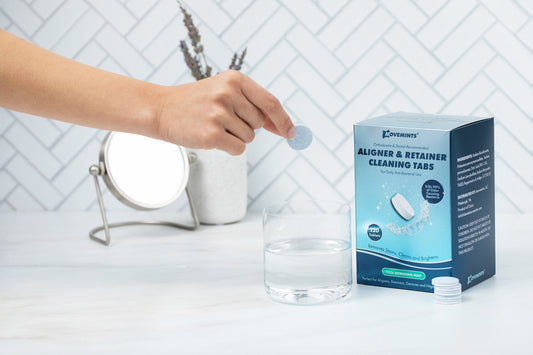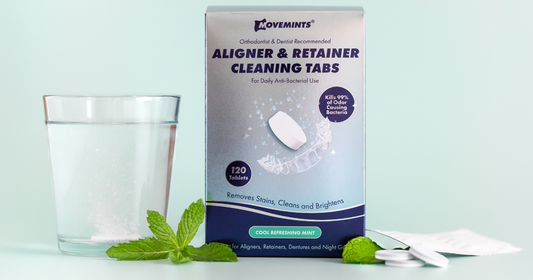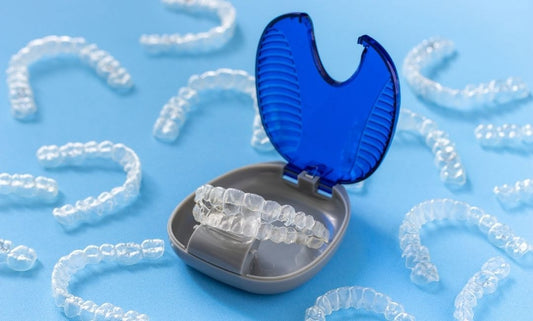Prevent Invisalign Gum Damage by Flossing During Treatment
Oral hygiene is key to a healthy mouth. Regular brushing and flossing can prevent Invisalign gum damage and cases of chronic bad breath. But tragically, data from the American Dental Association shows that only 50.5 percent of Americans floss every day—like they should—and less than 20 percent don’t even floss at all.
Daily flossing is important throughout your life, but especially so during Invisalign treatment. When you cover your teeth with an Invisalign retainer for 22 hours each day, you’re creating a prime environment for bacteria to accumulate on your teeth, worsening your risk of the problems previously mentioned. You should be flossing anyways, but here's some extra motivation for when you don't always feel up to the task:
- It’s riskier to skip flossing during Invisalign treatment
- Flossing is more than just removing food
- It’s not inconvenient
- Some products make it easier to floss on the go
While it’s nobody’s favorite thing, flossing is key to a healthy mouth regardless of previous or current orthodontic treatment. But if you are going through Invisalign treatment, try to floss after every meal, or at least once a day. Read on to find out why.
Techniques to Prevent Invisalign Gum Damage & Other Maladies During Treatment
Certain people are more predisposed to dental complications than others, depending on individual enamel strength. Saliva pH and tooth alignment—yes, the way your teeth are shaped—can make you more susceptible to gum disease. If you’re using Invisalign, there’s a good chance it’s because you are unhappy with your current teeth alignment. Dr. David Pechersky, Orthodontist and inventor of Movemints clear aligner mints, highlights the importance of flossing when your teeth aren't evenly aligned:
“Overlapping teeth contact each other from their edge all the way down to the gums, preventing the bristles of the toothbrush from going through.”
Pechersky points out that flossing is the least expensive and most efficient way to clean teeth that overlap, so get flossing!
Here’s something else to think about. When you finish eating and put your clear aligners back on, it could be awhile before you take them out again. If food does get lodged in your teeth after a meal, those particles get to sit in a moist, bacteria-inducing environment because your teeth are covered by the trays. That’s about as bad for your teeth as it sounds, and a primary contributor to Invisalign bad breath.
So try to floss after every meal to prevent this from happening during your Invisalign treatment. If that sounds like a pipe dream during your busy day, consider using floss picks like Knotty Floss, included in our Ultimate Invisalign Accessory Kit. They are made with biodegradable cornstarch and grapefruit seed extract-infused floss!
More than Just Removing Food
When you think of a string of floss, there’s a good chance you think of its powers of food removal. While this is true, there are many other reasons to floss that benefit your oral health. In addition to reaching the spots your toothbrush can’t reach, there are other things to keep in mind when debating the importance of flossing.
Plaque
Dental plaque is a sticky film of bacteria, sugars, and stuff from everything else we eat that forms on the teeth. If plaque is not removed by flossing and brushing, it can harden into tartar and cause tooth decay.
Plaque is constantly building in the mouth. As this plaque accumulates, the bacteria in it will damage your teeth by wearing away at the enamel. The bacteria produces harmful acids in your mouth, which travel to the teeth roots under the gums and damage the bone supporting your teeth. In addition to regular flossing and brushing, here are some things you can do to help prevent plaque buildup:
- Lower your sugar consumption, especially from starchy and sticky snacks
- Visit your dentist regularly for a cleaning
As scary as that plaque buildup sounds, trapping it on your teeth under Invisalign trays is even worse. Flossing helps to break up that plaque buildup that would otherwise be fertilizing between your teeth and your clear aligners.
Disease
According to the American Dental Association, more than 500 bacterial species can be found in plaque. While not all of those are bad bacteria, there are plenty that can contribute to gum disease by accumulating near the teeth and gum line.
Gingivitis (gum inflammation) is the first step to periodontitis (gum disease). Dr. Wayne Aldredge, President of the American Academy of Periodontology—a group of more than 8,000 gum-disease-fighting doctors—said “gum disease is typically caused when prolonged exposure to bacteria in dental plaque causes an inflammatory reaction. Flossing is an effective and useful way to remove the plaque, especially between the teeth or under the gum line—places where a toothbrush cannot reach.”
Fortunately, gingivitis can be reversed with efficient oral care. But if left untreated, plaque will spread and accumulate below the gum line causing a more severe form of gum disease.

Flossing with Invisalign is much easier than flossing with traditional metal braces, so there’s less of a reason to skip.
Flossing Doesn’t Have to Be Inconvenient
It can be much more difficult to floss with traditional metal braces. There’s a certain way you have to go over and under the metal wire, and it can definitely keep you at the bathroom mirror for a longer time than you anticipated.
But with Invisalign, you can’t use metal wire problems as an excuse. All that’s required of you to floss with Invisalign is just to take the trays out, so there’s no reason to skip flossing. But we realize maintaining excellent oral hygiene is easier said than done, and certainly not convenient when you're trying to live your busy life. That's why we conclude this blog with a quick review of our favorite Invisalign accessories that make getting into a consistent routine easy and fun!
Must Have Invisalign Accessories for On-the-Go Hygiene
We'll start (naturally) with Movemints, the only mints you should be eating with your clear aligners. Movemints are the purest mint you can find, and they're perfect for maintaining oral hygiene during your busy day. Not only do they help you wear your trays comfortably, they also freshen breath and fight dry mouth because they're sweetened with xylitol, a naturally occurring sugar substitute recommended by dentists and orthodontists as a treatment for dry mouth.
Someone else seemed to think as highly of Movemints—those in charge of compiling the 2019 Grammy Gift Bag! When putting together the $30,000 gift bag for the celebs, the organizers threw in another great product for oral hygiene on the go: those floss picks from Knotty Floss. They're an excellent addition to your oral hygiene arsenal that’s easy to use and environmentally friendly. In addition to the cornstarch handles, the floss is infused with ingredients like bamboo and grapefruit seed extract to freshen breath, whiten teeth, and prevent that dreaded gum disease.
One thing Movemints and Knotty Floss picks have in common is they don't require you to put your hands into your mouth, which can be a big no-no especially during cold and flu season. Many people use their hands to remove their aligners, which is sub optimal for a few reasons. Instead, we recommend Orthokey, a convenient tool that removes your trays without any finger-fishing around in your mouth.
Try all of these products to help your oral health during Invisalign treatment. Knotty Floss picks are especially helpful for flossing after meals when you’re away from the bathroom sink at home, and Movemints and OrthoKey are great for making the Invisalign process more efficient. We put them all together in our convenient Invisalign starter kit, so you can save time and money with one stop shopping for these must-have accessories.
Ultimately, it’s important to be flossing anyways, but it’s crucial during Invisalign treatment. Your teeth are already subject to bacteria and aligner trays only give it a better environment to grow in your mouth, contributing to dental disease and bad breath. Be sure to visit your dentist/orthodontist in appropriate intervals as well for cleanings and additional upkeep, and establish a consistent, healthy oral hygiene routine using the accessories we feature above.
Why do you think it’s important to floss during Invisalign treatment? Let us know in the comments!




